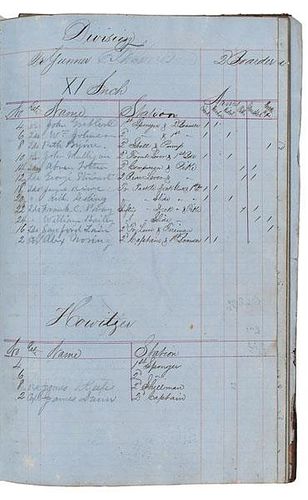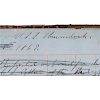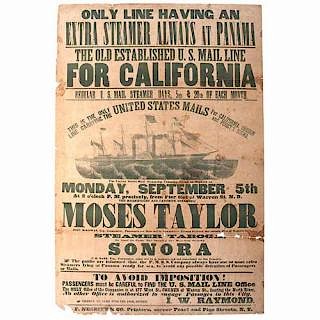Civil War Watch Quarter and Station Bill of the USS Lackawanna
About Seller
6270 Este Ave.
Cincinnati , OH 45232
United States
With offices in Cincinnati, Cleveland and Denver, Cowan’s holds over 40 auctions each year, with annual sales exceeding $16M. We reach buyers around the globe, and take pride in our reputation for integrity, customer service and great results. A full-service house, Cowan’s Auctions specializes in Am...Read more
Two ways to bid:
- Leave a max absentee bid and the platform will bid on your behalf up to your maximum bid during the live auction.
- Bid live during the auction and your bids will be submitted real-time to the auctioneer.
Bid Increments
| Price | Bid Increment |
|---|---|
| $0 | $25 |
| $500 | $50 |
| $1,000 | $100 |
| $2,000 | $250 |
| $5,000 | $500 |
| $10,000 | $1,000 |
| $20,000 | $2,500 |
| $50,000 | $5,000 |
| $100,000 | $10,000 |
About Auction
Jun 10, 2016 - Jun 11, 2016
Cowan's Auctions dawnie@cowans.com
- Lot Description
Civil War Watch Quarter and Station Bill of the USS Lackawanna
Watch Quarter and Station Bill identified to the USS Lackawanna, which was a screw sloop-of-war commissioned on January 8, 1863 and ordered to join the West Gulf Blockading Squadron at Pensacola. She served off Mobile Bay for the majority of the rest of the war. Lackawanna captured two prizes (Neptune and Planter) and 12 of her sailors were awarded the Medal of Honor for actions during the Battle of Mobile Bay, in which she was heavily involved: John M. Burns, Michael Cassidy, Louis G. Chaput, Patrick Dougherty, John Edwards, Samuel Kinnaird, Adam McCullock, William Phinney, John Smith, George Taylor, James Ward, and Daniel Whitfield. At least four appear in this log book.
8.25 x 13.5 in., marbled paper boards, 3/4 leather (snakeskin?). Front with label "Watch quarter and Station Bill / U.S. Ship Lackawanna." Not identified to person. In "The Civil War Sailor's Life," (civilwarhome.com/sailorlife) it is noted: Once a man reported to a ship in the regular service, he was assigned to various stations at the guns, on deck, in the tops, in a boat, at a mess, and in a hammock. Each had a number to be remembered....Until all these assignments became second nature to him, the recruit might forget his numbers and have to refresh his memory by consulting the station bill, where everyone's position was recorded" (accessed 4/28/2016). This log is a master list of these stations for one watch on the USS Lackawanna.
There are assignments for at least 248 men, although the volume is missing a couple pages, as the numbering jumps from 59 to 138 near the beginning. The officer has recorded Forecastle Starboard and Port, Fore Top Starboard (Port missing), Petty Officers Port and Idlers Port (Starboard missing for both), Marines Starboard and Port, Firemen Starboard and Port and their respective Coal Heavers. Then there are gun assignments (Nos. 1 - 7), Forward and After Supply Divisions, Officer's Stations at "All Hands."
There follows a page with "Watch Bill" near the center followed by another list of the same positions, but Fore Top Port, Main Top Starboard and Port, Afterguard Starboard and Port, and the Starboard Petty Officers and Idlers are included in this watch list. This is followed by Boat Crews, First through Fourth Divisions, more guns (24 Pounder, Howitzer, Masters Division, Forward and After Powder Divisions, Engineers Division, plus Divisions fro Surgeon, Paymaster, and Quarter Deck.
Interspersed within are instructions. In this case, a Fire Bill, outlining who needs to be informed (and what order), how to attach hoses, and everyone else's duties. For example: "The Officers commanding the Powder Divisions will themselves see that the gunner and his mate have the keys of the Magazine and Shell Rooms. The Master at Arms and Ships Corporal at their respective Light Rooms, prepared to open the cocks and flood the Magazines and Shell rooms, if so ordered, and take special care that the Shell Rooms and the Magazines, and their passages are kept closed till orders to the contrary are received from the Captain. With the men of their divisions they will man the force pumps, and the Office of the Forward Powder Division will have the suction hose led outside to the water through an airport.... The Surgeon will be ready to destroy or remove any inflammable articles in his storeroom, and will call on the Officer of the Forward Powder Division for assistance in doing so, or for removing the Sick..." and so on with instructions for each division. Everyone needs to know what to do for fire aboard ship.
This section is followed by other orders, such as days to scrub clothes, decks, bright wood work, with or without sand, holystone the deck, etc., then Drills are listed (Great Guns, Small Arms, and so on). On Sunday, the drill pages notes: The Executive Office will cause the Officers and men to dress in the Uniform he may designate.
About the middle of the volume are notes concerning a cruise of the USS Shenandoah to Hiogo, Japan, 1868. It gives the position of the ship each day going from Nagasaki Harbor to Hong Kong, noting the conditions along the way, such as positions of shoals, access to harbors, and obstacles encountered. The ship then proceeds from Hong Kong to Batavia, Java. The remainder of the pages are blank, except for the last page and rear pastedown.
Provenance: The M. Clifford (Cliff) and Lynne B. Young Confederate Blockade Runner CollectionMuch of the leather corner tabs is flaking. Heavy wear to boards. Occasional water damage (not unexpected). Part is in pencil with erasures. Other parts appear to be rough drafts with numerous strike-throughs.Condition
- Shipping Info
-
SHIPPING. At the request of the buyer, Cowan's will authorize the shipment of purchased items. Shipments usually occur within two weeks after payment has been received. Shipment is generally made via UPS Ground service. Unless buyer gives special instructions, the shipping method shall be at the sole discretion of Cowan's Auctions, Inc.. Cowan's is in no way responsible for the acts or omissions of independent handlers, packers or shippers of purchased items or for any loss, damage or delay from the packing or shipping of any property.
-
- Buyer's Premium



 EUR
EUR CAD
CAD AUD
AUD GBP
GBP MXN
MXN HKD
HKD CNY
CNY MYR
MYR SEK
SEK SGD
SGD CHF
CHF THB
THB
















